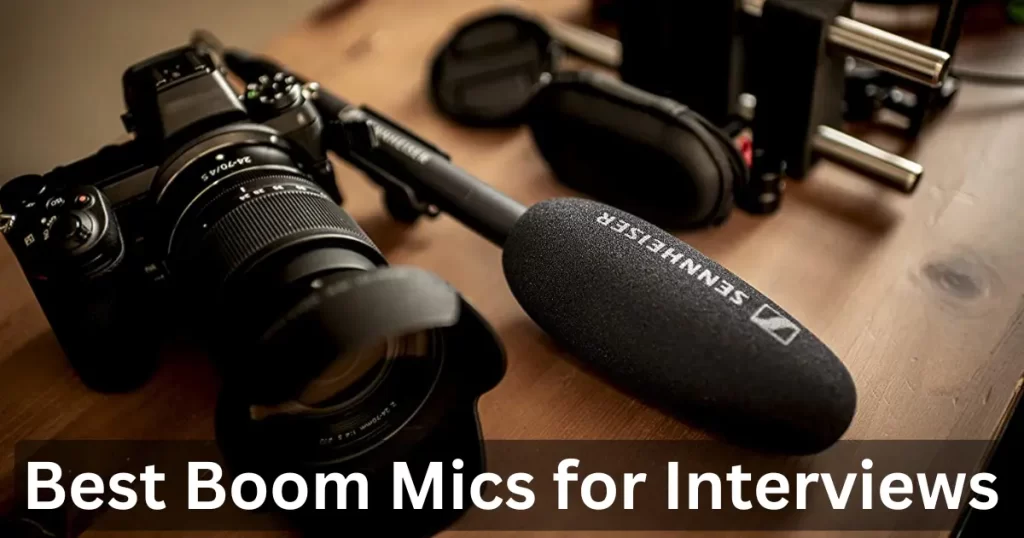Best Boom Mics for Interviews: Elevate Your Audio Quality 2024

In the world of journalism, podcasting, and video production, interviews are an essential part of the process. Whether you’re interviewing a celebrity, a politician, or a regular person on the street, the success of the interview often depends on the quality of the audio.
Boom mics are a type of directional microphone that is mounted on a boom pole and held above or beside the subject being recorded. They are highly effective at capturing clear and focused audio, even in noisy or crowded environments.
Best Boom Mics for Interviews
By investing in a good boom mic, you can ensure that your interviews sound professional and engaging, which can make a huge difference in the success of your project.
So, whether you’re a journalist, a podcaster, or a videographer, it’s worth taking the time to find the right boom mic for your needs. Let’s dive in and explore the options!
1. Sennheiser MKE 600
Sennheiser MKE 600

- Ideal video camera/camcorder microphone
- High directivity
- Switchable “Low Cut” filter
- Phantom or battery powering
- Supplied with foam windshield and shock mount
The Sennheiser MKE 600 is a popular boom microphone that is commonly used for interviews, film and video productions, and other applications where directional audio is needed.
This microphone is a shotgun-style microphone with a super-cardioid directional pickup pattern, which means that it captures sound mainly from the front while minimizing sound from the sides and rear.
It is designed to deliver high-quality audio with low self-noise and low distortion, making it a reliable choice for professionals in various industries.
The MKE 600 is also known for its rugged construction and versatility. It has a switchable low-cut filter to reduce low-frequency noise, making it suitable for use in a variety of environments.
Additionally, it comes with a foam windshield to protect the microphone from wind noise and other disturbances.
Overall, the Sennheiser MKE 600 is a high-quality and versatile boom microphone that can provide clear and focused audio for interviews and other applications. It is a reliable and durable choice for professionals who require excellent sound quality and directional pickup capabilities.
Pros
- Excellent directional capabilities and low self-noise
- Rugged and durable construction
- Switchable low-cut filter to reduce low-frequency noise
- Comes with a foam windshield to protect from wind noise
Cons
- Battery life can be shorter compared to some other boom mics
- Some users have reported that it can be heavy and unwieldy to use for long periods of time
Also Read:
Joe Rogan’s Favorite Microphone for Podcasting & other Audio Production
2. Rode NTG4 Plus
Rode NTG4+ Shotgun Microphone

- Super-cardioid directional pickup pattern
- Built-in rechargeable battery
- Digital switching system
- Compact and lightweight design
- Compatible with standard XLR cables and most audio equipment
The Rode NTG4 Plus is a highly-regarded boom microphone that is well-suited for interviews, film and video productions, and other applications where directional audio is essential.
This shotgun-style microphone features a super-cardioid directional pickup pattern, which means that it captures sound mainly from the front while minimizing sound from the sides and rear. The NTG4 Plus also has an extended frequency range, making it ideal for capturing high-quality audio in a wide range of settings.
One of the unique features of the NTG4 Plus is its built-in rechargeable battery, which allows for up to 150 hours of continuous operation.
This makes it an excellent choice for on-the-go professionals who need a reliable microphone that won’t run out of power during important interviews or productions.
Additionally, the microphone comes with a digital switching system that allows you to control the high-pass filter, high-frequency boost, and other settings directly from the microphone.
The Rode NTG4 Plus also comes with a range of accessories to help you achieve the best possible sound quality. These include a foam windshield to reduce wind noise, a zippered storage pouch, and a micro-USB cable for recharging the battery.
Overall, the Rode NTG4 Plus is an excellent choice for professionals who require high-quality directional audio in a variety of settings.
Its impressive battery life, digital switching system, and versatile accessories make it a reliable and convenient choice for interviews, film and video productions, and other applications.
Pros
- Built-in rechargeable battery with up to 150 hours of continuous use
- Digital switching system allows for easy control of microphone settings
- Comes with a range of accessories, including a foam windshield and micro-USB cable
- Compact and lightweight design
Cons
- Some users have reported that the digital controls can be difficult to navigate
- May not be as durable as some other boom mics
3. Audio Technica AT897
Audio Technica AT897

- Designed for broadcast & video production
- Short length (11″)
- Smooth on-axis audio quality with excellent off-axis rejection
- Narrow acceptance angle
- Operates on battery or phantom power
- Switchable low-frequency roll-off
The Audio Technica AT897 is another popular boom microphone that is widely used in professional settings. It is a shotgun-style microphone with a directional polar pattern that helps to capture audio from a specific area while reducing ambient noise.
One of the standout features of the AT897 is its compact size and lightweight design. This makes it a highly portable and versatile microphone that can be used in a variety of settings, including interviews, documentaries, and film and video productions.
Despite its small size, the microphone is highly sensitive and can pick up audio from a distance without compromising on quality.
The AT897 also comes with a range of accessories that can help to improve the quality of your audio recordings. These include a windscreen to reduce wind noise, a shock mount to reduce handling noise, and a carrying case to protect the microphone during transport.
Another advantage of the Audio Technica AT897 is its compatibility with a wide range of audio equipment. The microphone can be used with standard XLR cables and is compatible with most audio interfaces, mixers, and recorders.
Overall, the Audio Technica AT897 is a highly portable and versatile boom microphone that is well-suited for interviews and other professional settings.
Its compact size, high sensitivity, and range of accessories make it an excellent choice for professionals who require high-quality directional audio in a range of different environments.
Pros
- Compact and lightweight design makes it highly portable
- High sensitivity and excellent directional capabilities
- Compatible with most audio equipment and XLR cables
- Comes with a range of accessories, including a windscreen and shock mount
Cons
- May not be as sensitive as some other options
- Some users have reported that the included windscreen is not very effective in reducing wind noise
Factors to consider when choosing a boom mic for interviews
When choosing a boom mic for interviews, there are several factors to consider. These include:
1. Directionality:
Boom mics come in different directional patterns, including cardioid, supercardioid, and hypercardioid.
Cardioid mics are best for capturing sound from one direction, while supercardioid and hypercardioid mics offer even more focused sound pickup. Consider which directional pattern is best for your interview setting.
2. Sensitivity:
The sensitivity of a microphone refers to its ability to pick up sound. A more sensitive microphone will capture quieter sounds, but may also pick up unwanted background noise. Consider the level of sensitivity you need for your interview setting.
3. Noise-cancelling:
A good boom mic should have noise-cancelling features that help eliminate background noise and other unwanted sounds. Look for microphones with built-in noise reduction technology or ones that come with a windscreen or shock mount to reduce vibrations.
4. Size and weight:
The size and weight of a boom mic are important factors to consider, especially if you’ll be holding the boom pole for an extended period. A lightweight and compact mic will be easier to maneuver and less tiring to hold, while a larger, heavier mic may be more difficult to handle.
5. Connectivity:
Consider the type of connectivity you need for your microphone. Some boom mics require XLR cables, while others can connect wirelessly via Bluetooth or other technologies.
By considering these factors, you can choose a boom mic that’s best suited for your interview needs and will provide high-quality sound capture.
Tips for using a boom mic in interviews
Using a boom mic in interviews can help you capture high-quality audio and make your recordings more professional. Here are some tips for using a boom mic effectively during interviews:
1. Position the microphone correctly:
The position of the microphone is crucial for capturing clear and focused audio. The boom mic should be positioned as close to the subject’s mouth as possible, without appearing in the shot. The ideal position is usually above and slightly in front of the subject, pointing down towards their mouth.
2. Monitor the audio:
When using a boom mic, it’s essential to monitor the audio levels to ensure that you’re capturing clear sound. Use headphones to listen to the audio as you record and adjust the microphone’s position and settings as needed.
3. Use a windscreen or shock mount:
Wind noise and handling noise can ruin an otherwise good recording. Use a windscreen or shock mount to reduce these noises and improve the overall quality of the audio.
4. Be mindful of background noise:
Background noise can be distracting and reduce the quality of your recording. Try to record in a quiet location, and use the microphone’s directional capabilities to focus on the subject’s voice while minimizing ambient noise.
5. Test the microphone before recording:
Before you begin recording, it’s a good idea to test the microphone to make sure it’s working correctly. Check the battery level, make sure it’s connected properly, and do a test recording to check the audio levels.
By following these tips, you can make sure you’re getting the most out of your boom mic and capturing high-quality audio during interviews. With a little practice and attention to detail, you can achieve professional-sounding recordings that will make your interviews stand out.
Also Read:
- Best Mic for Motovlogging 2024
- Best External Mic for GoPro Motorcycle 2024
- Top 5 Best Wireless Microphones for Vlogging
- 5 Best Omnidirectional Microphones
- Joe Rogan’s Favorite Microphone for Podcasting
FAQs:
Can I use a shotgun microphone for indoor interviews?
Yes, shotgun microphones are versatile and can be used for indoor interviews as well as outdoor settings. However, it’s important to consider the acoustics of the indoor environment and choose a shotgun microphone with a narrower pickup pattern to minimize echo or reverberation.
Can I use a boom mic with my smartphone for interviews?
Yes, many boom mics are compatible with smartphones using adapter cables or connectors. However, it’s important to check the compatibility of the boom mic with your specific smartphone model, and also consider the length and flexibility of the boom pole to ensure it can be easily used with a smartphone setup.
Do I need a boom operator to use a boom mic?
Not necessarily. You can use a boom pole with a shock mount and position the microphone yourself, as long as you’re comfortable with the task. However, a skilled boom operator can help you achieve more precise positioning and reduce handling noise, resulting in better quality audio.
How do I store and transport a boom mic?
Most boom mics come with a storage case or pouch to protect the microphone during transport. You should also store the microphone in a cool, dry place and avoid exposing it to extreme temperatures or humidity.
Do I need to use a boom mic for every interview?
Not necessarily. Depending on the setting and the number of people involved, a lavalier mic or a handheld mic may be more appropriate. However, if you want to capture clear and focused audio with minimal background noise, a boom mic is usually the best option for interviews.
Can I use a boom mic with a wireless transmitter?
Yes, some boom mics can be used with wireless transmitters for added convenience and flexibility. However, wireless transmission can sometimes result in interference and reduced sound quality, so it’s important to choose a reliable wireless system and test it before recording.
Conclusion:
A good boom mic is essential for capturing clear and high-quality audio during interviews. By choosing a boom mic with the right directional pattern, sensitivity, noise-cancelling features, and size, you can ensure that your interviews sound professional and engaging.
Some of the top boom mics for interviews include the Sennheiser MKE 600, Rode NTG4 Plus, and Audio Technica AT897, each with their own unique features and benefits.
When using a boom mic for interviews, it’s important to position it correctly, monitor the audio, use a windscreen or shock mount, be mindful of background noise, and test the microphone before recording.
By following these tips and investing in a quality boom mic, you can elevate the audio quality of your interviews and make them more engaging and enjoyable for your audience. So whether you’re a journalist, podcaster, or videographer, take the time to choose the right boom mic for your needs and create high-quality content that stands out from the rest.



